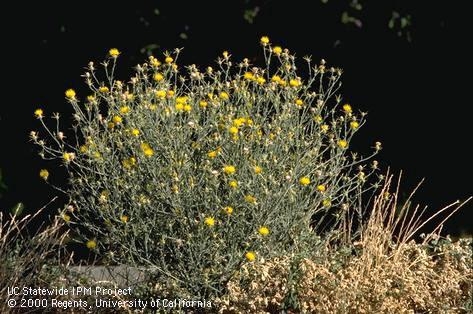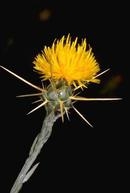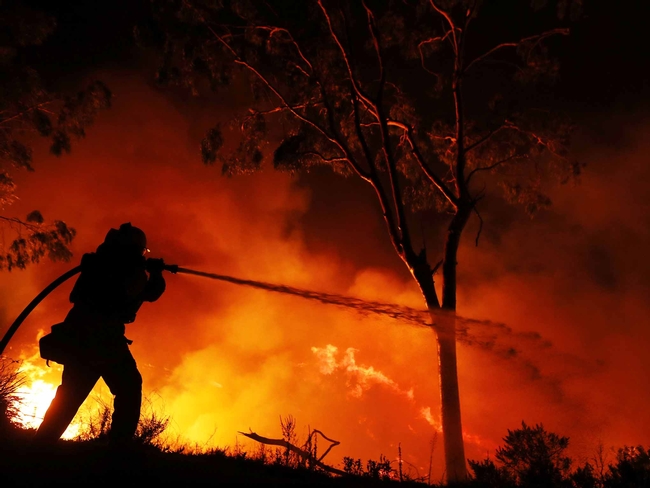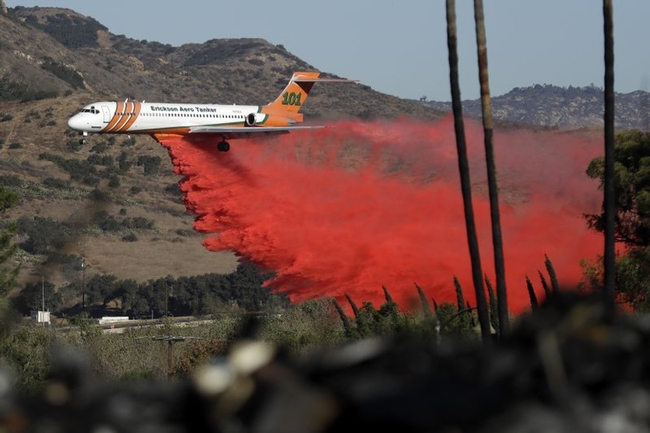
Posts Tagged: wildfire
Fire Resources
Current fire activity in Ventura County reminds us that fire season is here. It's critical to be prepared. Here are some important resources to help you get ready and stay apprised of fire activity in Ventura County.
For the latest fire incident information, visit the Ventura County Fire Department website. This website also contains a wildfire action plan for farmers, ranchers and growers.
We also suggest you bookmark the VC Emergency portal. You can access the Ventura County Emergency Preparedness Guide in English and Spanish.
Here are other resources we recommend:
- Fire in California This is UC ANR's comprehensive fire resources website. This site contains the latest information on fire ecology; wildfire preparation; health and safety in wildfires; wildfire recovery; and more. Useful information for homeowners, land owners and land stewards.
- CA Fire Science Consortium is a network of scientists and managers that strives to increase the awareness, understanding, and adoption of wildland fire science information.
- LUC Lab at UC-Berkeley researching land and land use change.
- ReadyForWildfire.org CalFire's fire resources website, which provides many valuable resources for preparedness.
- **NEW Wildfire Risk to Communities maps by US Forestry Service
Be sure to follow our UCCE Livestock & Range page on Facebook. Advisor Matthew Shapero helms that page and often posts fire information there. If you haven't had an opportunity to meet Matthew, you can learn more about his work in this blog post.
ICYMI, here's a #goodread about Pandemic and Wildfire: California is Preparing for a Crisis Within a Crisis
Stay safe.

Credit: Michael Held, Unsplash
Wildfire Training for Farm Workers
This content was developed by the Western Center for Agricultural Health and Safety at UC Davis. For more information and to access their wildfire training materials, visit their wildfire training page: https://aghealth.ucdavis.edu/wildfires
How do wildfires affect the health and safety of people in agriculture?
Farmers and farmworkers are at a greater risk for exposure to wildfire smoke, ash, and chemical residue due to their work outdoors and long shifts, both during an active fire as well as during cleanup and recovery. Due to the nature of agricultural work, it is difficult for farmers and farmworkers to stop working due to wildfires. Lost workdays and the potential destruction of crops can have an economic effect on both farmers and workers.
Regardless of their proximity to wildfires, agricultural workers can struggle with stress and other mental health issues related to the effects of wildfires. Income, access to healthcare, and immigration concerns increase the vulnerability of the farmworker population.
When a wildfire occurs, what protections and information are employers required to provide to employees?
The newly adopted regulation §5141.1 “Protection from Wildfire Smoke,” which went into effect on July 29, 2019, uses the local air quality index (AQI) for PM2.5 to determine when worker protections are needed.
If employers reasonably anticipate that employees may be exposed to wildfire smoke, they must:
What is included in the wildfire smoke safety training and resources provided by WCAHS?
WCAHS provides safety resources on wildfire smoke for both employers and employees. An employer checklist outlining the above action items is available in English and Spanish. For training purposes, a double-sided poster and accompanying discussion guide are available in English and Spanish and are useful tools for tailgate trainings and safety reminders in the workplace.
WCAHS is developing an in-person training for agricultural employers and employees that provides a more comprehensive and in-depth review of the health effects of wildfire smoke exposure, worker protection procedures, and more.
Find out more about the Western Center for Agricultural Health and Safety and the Training Program Schedule: https://aghealth.ucdavis.edu/wildfires

smoke health poster spanish
Emergency Avocado & Citrus Post-Wildfire Informational Meeting in Fallbrook
University of California Cooperative Extension & USDA Farm Service Agency
Presents
Emergency Avocado & Citrus Post-Wildfire Informational Meeting
We understand this is a difficult time for all of our friends, family and neighbors affected by the devastating Lilac fire. In hopes of providing some assistance and relieving some anxiety, we assembled an informational meeting to provide resources to help growers deal during this overwhelming time.
Date: Tuesday, December 19, 2017
Time: 1:00-4:00 PM
Location: 990 E. Mission Rd, Fallbrook CA 92028, Fallbrook Public Utility Building
There is no cost to attend this event
Please register at: https://ucanr.edu/survey/survey.cfm?surveynumber=22511
Agenda
1:00- 1:10 - Introduction: Sonia Rios, Subtropical Horticulture Farm Advisor, UCCE Riverside/San Diego
1:10- 1:30- Fire Update and Safety: CAL FIRE
1:30- 2:00- Post Fire Tree Care- Gary Bender, Emeritus, Subtropical Horticulture Farm Advisor, UCCE San Diego
2:00- 2:20 Post Fire Tree Economics- Eta Takele, Agriculture Economics Advisor, UCCE Riverside
Break
2:30-3:30-Desiree Garza, USDA Farm Service Agency
3:30: 3:55- Preventative Fire Safety for Orchard Systems-Sonia Rios, Subtropical Horticulture Farm Advisor UCCE Riverside/San Diego Co.
3:55 Conclude Meeting
Will also be in attendance: Eric Klein, Dept. of Environmental Health, Debra Lorenzen, Community Recovery Team, and other resource agency's will be in attendance.
Light drinks and refreshments will be served
If you have any questions, please feel free to call: Sonia Rios, 951-683-6491 ext. 224
What Hath the Rain Wrought in the Avocado Foothills
Title: Area Livestock and Natural Resources Advisor
Specialty: Rangeland Ecology and Management, Rangeland Conservation, Grazing Management, Conservation of Biological Diversity, Watershed Protection and Management.
County: San Benito County
Address:
Cooperative Extension San Benito County
3228 Southside Road
Hollister, CA 95023
Phone: 831-637-5346 x14
Email: drorao@ucanr.edu
Do you have yellow starthistle, Italian thistle, Himalaya blackberry, white top, or other common Central Coast rangeland weeds on your ranch? If so, you may be wondering which herbicides are most effective, how much they cost, what is required to purchase and spray a particular herbicide, when to spray, whether the herbicide affects grasses or clovers, and if the herbicide is safe for your livestock and pets. Many Central Coast rangeland landowners have been asking these same questions. So, I compiled this information in two tables. Table 1 shows some of our common rangeland weeds and different herbicide treatment options. Table 2 lists six of the most commonly used rangeland herbicides, and answers questions about cost, when to spray, purchasing requirements, affected plants, and grazing/pet restrictions. All of this information is already available from a variety of sources, but I have put it together in two easy to use reference tables. The tables are self-explanatory for the most part, but the information below may clarify a few things.
Integrated Pest Management (IPM)
IPM is a weed management approach that uses multiple control methods. Control methods could include mechanical control, manual control, grazing, seeding, herbicide, etc. The most effective options will depend on the particular species you are trying to control. This blog post focuses on herbicide because I am often asked about chemical treatment options. However, your weed control efforts will likely be most successful if you use a variety of methods.
Operator ID's, Restricted Materials Permits, & Private Applicator Certificates
Most of the herbicides in Table 2 are general use pesticides, meaning that you only need an operator ID to purchase and use them (Carbonaro, pers. comm.). Operator ID's are free and can be obtained from your County Agricultural Commissioner's office. No test is required. But, you'll need to show a property map in order to get your operator ID.
One herbicide in Table 2, 2, 4-D, is a California state restricted pesticide when applied on rangelands. Before you can purchase or spray California state restricted pesticides, two things are required: a Private or Commercial Applicator Certificate and a restricted materials permit. You can get a Private Applicator Certificate from your County Ag Commissioner's office. This requires taking a free test. The test is based on Pesticide Safety: A Reference Manual for Private Applicators, 2nd Ed., published by the University of California. This book can be purchased from most County Ag Commissioner or UC Cooperative Extension offices or online at: http://anrcatalog.ucanr.edu/Details.aspx?itemNo=3383. Once you have your Private Applicator Certificate you'll be able to obtain a restricted materials permit, again from your County Ag Commissioner's office. Alternatively, you can hire a licensed pest control business to purchase and spray California state restricted pesticides.
Read Labels, Follow Federal, State & Local Regulations, and Report Pesticide Use to Your County Ag Department
Although Table 2 includes information from the herbicide labels, it is not a substitute for reading the entire herbicide label before you spray (Carbonaro, pers. comm.). Always read the label before using any of these herbicides. In California, in addition to following the label, applicators will also need to follow federal, state, and local regulations. And, remember that you should submit a pesticide use report to your County Agricultural Commissioner's office for all pesticides used on rangelands.
For additional information about weeds and how to manage them, check out this website: http://wric.ucdavis.edu. The Invasive Thistles of Bay Area Counties & Herbicides for Controlling Thistles Handout compiled by Guy Kyser, UC Cooperative Extension Specialist in Weed Science at UC Davis is a great resource and is attached at the bottom of this blog post.
References
Carbonaro, D. 2017. Personal communication, 4/16/2017. Carbonaro is a Senior Biologist/Inspector with the San Benito County Agricultural Commissioner's Office.
DiTomaso, J.M. G.B. Kyser et al. 2013. Weed Control in Natural Areas in the Western United States. WRIC, UC.
Kyser, G. Unpublished. Invasive Thistles of Bay Area & Herbicides for Controlling Thistles.
Table 1. Common Central Coast Rangeland Weeds
|
PlantSpecies |
Herbicides Options Approved for useon CaliforniaRangelands |
Rangeland Herbicides Known to beEffective |
|
|
Bullthistle (Cirsium vulgare) |
2, 4-D (Severalnames) Aminopyralid(Milestone) Clopyralid(Transline) Dicamba (Banvel,Clarity) Triclopyr (Garlon 3A/Garlon 4Ultra)Chlorsulfuron(Telar) Imazapyr (Arsenal,Polaris) |
Milestone, Transline, Capstone (=Milestone + Garlon),Garlon, Roundup (Kyser,unpublished)
2,4-D is often used because it is inexpensive. However, itis not as effective as otherherbicides. |
|
|
Bull thistle weed report: |
http://wric.ucdavis.edu/information/natural%20areas/wr_C/Cirsium_vulgare.pdf |
||
|
Cocklebur (commonand spiny cocklebur) (Xanthium strumarium) (Xanthium spinosum) |
2, 4-D (Severalnames) Aminopyralid(Milestone) Clopyralid(Transline) Dicamba (Banvel,Clarity) Fluroxypyr (VistaXRT) Triclopyr (Garlon 4 Ultra, RemedyUltra)Glyphosate (Roundup, Accord XRT II,and others) Imazapyr (Arsenal,Polaris) Sulfosulfuron(Outrider) |
Aminopyralid(Milestone) Clopyralid(Transline) |
|
|
Cocklebur weed report: |
http://wric.ucdavis.edu/information/natural%20areas/wr_X/Xanthium_spinosum-strumarium.pdf |
||
|
Fiddleneck (Menziesandcoastfiddleneck) (Amsinckiamenziesii)(Amsinckia menziesiivar. intermedia) |
Aminopyralid(Milestone) Glyphosate (Roundup, Accord XRT II,and others) Chlorsulfuron(Telar)Imazapyr (Arsenal,Polaris) Sulfosulfuron(Outrider)Hexazinone (VelparDF) |
Aminopyralid(Milestone) Chlorsulfuron(Telar) |
|
|
Fiddleneck weedreport: |
http://wric.ucdavis.edu/information/natural%20areas/wr_A/Amsinckia.pdf |
||
|
Foxtail (Mediterraneanand harebarley) (Hordeum marinumssp.gussonianum) (Hordeum murinumssp.leporinum) |
Glyphosate (Roundup, Accord XRT II,and others) Imazapyr (Arsenal,Polaris) Rimsulfuron(Matrix) Sulfometuron + chlorsulfuron(LandmarkXP) Sulfosulfuron(Outrider)Hexazinone (VelparL) |
Glyphosate (Roundup, Accord XRT II, and others) iseffective, but is nonselective, so will kill most other plants as well.If glyphosate is to be used, reseed to reduce bare groundand encroachment of other weedspecies.
Rimsulfuron (Matrix) will likely control control foxtail,based on limiteddata. |
|
Foxtail weedreport: |
http://wric.ucdavis.edu/information/natural%20areas/wr_H/Hordeum_marinum-murinum.pdf |
|
|
Frenchbroom (Genista monspessulana) |
Triclopyr (Garlon 3A, Garlon 4Ultra,PathfinderII) Aminopyralid + triclopyr(Capstone) Triclopyr + 2,4-D(Crossbow) Glyphosate (Roundup, Accord XRT II,and others) Imazapyr (Arsenal,Polaris) |
Triclopyr (Garlon 3A, Garlon 4 Ultra, PathfinderII)
Glyphosate (Roundup, Accord XRT II, and others) iseffective, but resprouts will need to be controlled. Glyphosateis nonselective, so will kill most other plants as well. Ifglyphosate is to be used, reseed to reduce bare groundand encroachment of other weedspecies. |
|
French broom weedreport: |
http://wric.ucdavis.edu/information/natural%20areas/wr_G/Genista.pdf |
|
|
Goatgrass (jointed and barbgoatgrass) (Aegilops cylindrica) (Aegilops triuncialis) |
Glyphosate (Roundup, Accord XRT II,and others) Sulfometuron + chlorsulfuron(LandmarkXP) |
Research is currently being conducted to identify most effective options for goatgrass. |
|
Goatgrass weedreport: |
http://wric.ucdavis.edu/information/natural%20areas/wr_A/Aegilops_cylindrica-triuncialis.pdf |
|
|
Himalayablackberry (Rubus armeniacus) |
Dicamba (Banvel,Clarity) Fluroxypyr (VistaXRT) Triclopyr (Garlon 3A, Garlon 4Ultra,PathfinderII) Aminopyralid + triclopyr (Capstone) Glyphosate (Roundup/Accord XRT II,and others) Hexazinone (VelparL) Tebuthiuron(Spike) |
Triclopyr (Garlon 3A, Garlon 4 Ultra, Pathfinder II) canbe effective on smallindividuals.
Glyphosate (Roundup/Accord XRT II, and others) canbe effective, but may requireretreatment. |
|
Himalaya blackberry weed report: |
http://wric.ucdavis.edu/information/natural%20areas/wr_R/Rubus.pdf |
|
|
Italian thistle (Carduus pycnocephalus) |
2, 4-D (Severalnames) Aminopyralid(Milestone) Aminopyralid + 2,4-D (ForefrontHL) Aminopyralid + triclopyr(Capstone) Clopyralid(Transline) Dicamba (Banvel,Clarity) Fluroxypyr (VistaXRT) Triclopyr (Garlon 3A, Garlon 4Ultra)Triclopyr + 2,4-D(Crossbow) Glyphosate (Roundup, Accord XRT II,and others) Chlorsulfuron(Telar)Imazapyr (Arsenal,Polaris) Hexazinone (VelparL) |
Aminopyralid (Milestone) is highly effective on thistles.
Milestone, Transline, Capstone (=Milestone + Garlon),Garlon, Roundup (Kyser,unpublished)
2,4-D is often used because it is inexpensive. However, itis not as effective as otherherbicides. |
|
Italian thistle weedreport: |
http://wric.ucdavis.edu/information/natural%20areas/wr_C/Carduus_acanthoides-nutans-pycnocephalus-tenuiflorus.pdf |
|
|
Medusahead (Taeniatherumcaput -medusae) |
Aminopyralid(Milestone) Glyphosate (Roundup, Accord XRT II,and others) Rimsulfuron(Matrix) LandmarkXP |
Aminopyralid (Milestone) provided up to 90% controlof medusahead based on research in the CentralValley. |
|
Medusahead weedreport: |
http://wric.ucdavis.edu/information/natural%20areas/wr_T/Taeniatherum.pdf |
|
|
Milkthistle (Silybum marianum) |
2, 4-D (Severalnames) Aminopyralid(Milestone) Clopyralid(Transline) Dicamba (Banvel,Clarity) Chlorsulfuron(Telar)Rimsulfuron(Matrix) |
Milestone, Transline, Capstone (=Milestone + Garlon),Garlon, Roundup (Kyser,unpublished) |
|
Milk thistle weedreport: |
http://wric.ucdavis.edu/information/natural%20areas/wr_S/Silybum.pdf |
|
|
Purple starthistle (Centaurea calcitrapa) |
2, 4-D (Severalnames) Aminopyralid(Milestone) Clopyralid(Transline) Dicamba (Banvel,Clarity) Glyphosate (Roundup, Accord XRT II,and others) Hexazinone (VelparL) |
Milestone, Transline, Capstone (=Milestone + Garlon),Garlon, Roundup (Kyser,unpublished) |
|
Purple starthistleweed report: |
http://wric.ucdavis.edu/information/natural%20areas/wr_C/Centaurea_calcitrapa-iberica.pdf |
|
|
Tumbleweed(Russian thistle) (Salsola tragus) |
2, 4-D (SeveralNames) Aminocyclopyrachlor +Aminopyralid(Milestone) Dicamba (Banvel,Clarity) Triclopyr (Garlon 3A, Garlon 4Ultra)Glyphosate (Roundup, Accord XRT II,and others) Chlorsulfuron(Telar)Imazapyr (Arsenal,Polaris) Hexazinone (VelparL) |
Research is currently being conducted to identify most effective options fortumbleweed. |
|
Tumbleweed weedreport: |
http://wric.ucdavis.edu/information/crop/natural%20areas/wr_S/Salsola_paulsenii-tragus.pdf |
|
|
Whitetop/hell weed (Cardaria draba) |
2, 4-D (Severalnames) Dicamba + 2,4-D Glyphosate (Roundup, Accord XRT II,and others Chlorsulfuron(Telar)Imazapyr (Arsenal,Polaris) |
Chlorsulfuron (Telar) is one of the best control optionsfor plants in the Cardariagenus.
2,4-D is often used because it is inexpensive. However, itis not as effective as otherherbicides. |
|
Whitetop weedreport: |
http://wric.ucdavis.edu/information/natural%20areas/wr_C/Cardaria_chalepensis-draba-pubescens.pdf |
|
|
Yellowstarthistle (Centaurea solstitialis) |
2, 4-D (Severalnames) Aminopyralid(Milestone) Clopyralid(Transline) Dicamba (Banvel,Clarity) Triclopyr (Garlon 3A, Garlon 4Ultra)Glyphosate (Roundup, Accord XRT II,and others) Chlorsulfuron(Telar)Imazapyr (Arsenal,Polaris) Hexazinone (VelparL) |
Aminopyralid (Milestone) is the best option to controlyellow starthistle.
Clopyralid (Transline) is also veryeffective.
Glyphosate (Roundup, Accord XRT II, and others) is thebest option in the lateseason. |
|
Yellow starthistleweedreport: |
http://wric.ucdavis.edu/information/natural%20areas/wr_C/Centaurea_solstitialis.pdf |
|
Table 2. Commonly Used Rangeland Herbicides, Including When and How to Use Them
|
Chemical Name/Product Name1 |
Price2* |
Registered for useonCalifornia rangelands3 |
Requirements to Purchase/Spray Herbicide3 |
Preemergent/ Postemergent1 |
Best time tospray4 |
TargetedPlants4 |
|
Triclopyr(Garlon 3A/Garlon 4Ultra,Remedy Ultra,PathfinderII) |
$70/gallon |
Yes |
Operator ID# |
Postemergent |
Spray after all of theweed seed has germinated,but before the plants getbig. |
Kills broadleaves, but not grasses
Killsclovers5 |
|
Aminopyralid(Milestone) |
$300/gallon |
Yes |
Operator ID# |
Preemergentand postemergent |
January -March |
Kills thistles andlegumes, and some otherbroadleaves, but notgrasses
Killsclovers5 |
|
Glyphosate (Roundup, Accord XRT II, and others) |
$21/gallon |
Yes |
Operator ID# |
Postemergent |
Spray after all of theweed seed has germinated,but before the plants getbig. |
Kills any greenvegetation. Tree leaves can be sprayed, but it will not be effectiveifsprayed on treetrunks. |
|
Chemical Name/Product Name1 |
Price2* |
Registered for useonCalifornia rangelands3 |
Requirements to Purchase/Spray Herbicide3 |
Preemergent/ Postemergent1 |
Best time tospray4 |
TargetedPlants4 |
|
Chlorsulfuron (Telar) |
$21/ounce |
Yes |
Operator ID# |
Preemergent, can also be usedas postemergent |
Spray around the timeof the first rains, a littlebefore or a little afterthe first rains is fine.Spraybefore seedilngs getbig. |
Check label for plants affected. This herbidiceisspecies specific. Although,itis generally safe on grasses1.
Killsclovers5 |
|
Clopyralid(Transline) |
$170/gallon |
Yes |
Operator ID# |
Postemergent |
Spray after all of theweed seed has germinated,but before the plants getbig. |
Kills thistles and legumes,but notgrasses
Killsclovers5 |
|
2, 4-D (DMA4IVM, Weedar 64and manyothers) |
2, 4-D Amine- $13/gallon2, 4-D Ester- $19/gallon |
Yes |
Restricted materialspermit and applicator certificate |
Postemergent |
Spray after all of theweed seed has germinated,but before the plants getbig. |
Kills broadleaves, but not grasses
Killsclovers5 |
|
Triclopyr(Garlon 3A/Garlon 4Ultra,Remedy Ultra,PathfinderII) |
"Grazing green forage: There are no grazing restrictions for livestock or dairy animals on treated areas...Haying (harvesting ofdried forage): Do not harvest hay for 14 days after application...Slaughter Restrictions: During the season of application, withdrawlivestock from grazing treated grass at least 3 days before slaughter...Livestock Use of Water from Treatment Area: There are no restrictionson livestock consumption of water from the treatmentarea." Herbicide Label:https://s3-us-west-1.amazonaws.com/www.agrian.com/pdfs/Garlon_3A_Label1i.pdf |
|
Aminopyralid(Milestone) |
"Grazing and Haying Restrictions: There are no restrictions on grazing or grass hay harvest following application of Milestone atlabeledrates. Cutting hay too soon after spraying weeds will reduce weed control. Wait 14 days after herbicide application to cut grass haytoallow herbicide to work. Do not transfer grazing animals from areas treated with Milestone to areas where sensitive broadleafcrops occur without first allowing 3 days of grazing on an untreated pasture. Otherwise, urine and manure may contain enoughaminopyralidto cause injury to sensitive broadleaf plants...For applications on rangeland and permanent grass pastures (not harvested for hay)andnon-cropland areas, do not enter or allow worker entry into treated areas until sprays have dried...Grazing Poisonous Plants:Herbicideapplication may increase palatability of certain poisonous plants. Do not graze treated areas until poisonous plants are dry andnolonger palatable to livestock...Hay from grass treated with Milestone within the preceding 18-months can only be used on the farmor ranch where the product is applied unless allowed by supplemental labeling." Check label for specific restrictions on moving hay,or using hay for silage,etc. Herbicide Label:https://s3-us-west-1.amazonaws.com/www.agrian.com/pdfs/Milestone_Label1h.pdf |
|
Glyphosate (Roundup, Accord XRT II, and others) |
"DOMESTIC ANIMALS: This product is considered to be relatively nontoxic to dogs and other domestic animals; however, ingestionof this product or large amounts of freshly sprayed vegetation may result in temporary gastrointestinal irritation (vomiting, diarrhea,colic, etc.). If such symptoms are observed, provide the animal with plenty of fluids to prevent dehydration. Call a veterinarianifsymptoms persistfor morethan24hours...Donotfeedor grazeturfgrass grownfor seedor sodproductionfor 8weeks followingapplication...If application rates total 4.5 pints per acre or less, no waiting period between treatment and feeding or livestockgrazing is required. If the rate is greater than 4.5 pints per acre, remove domestic livestock before application and wait 8 weeksafter application before grazing orharvesting." Herbicide Label:https://s3-us-west-1.amazonaws.com/www.agrian.com/pdfs/Roundup_Custom_Label2.pdf |
|
Chlorsulfuron (Telar) |
"There are no grazing or hay harvest restrictions for any livestock, including lactating animals, with application rates up to 11/3 ounces/acre of TELAR® XP. No exclosure is required for any animals. Do not apply more than 1 1/3 ounces/acre of TELAR® XP peracreper year. No exclosure is required for anyanimals." Herbicide Label:https://s3-us-west-1.amazonaws.com/www.agrian.com/pdfs/DuPont_Telar_XP_Herbicide_Label5a.pdf |
|
|
|
|
Clopyralid(Transline) |
"Grazing/Haying: There are no restrictions on grazing or hay harvest following application of Transline at labeled rates exceptfor exported grass hay from California, Nevada, Washington and Oregon (see instructions in the Range and Permanent GrassPasturesection)...Do not transfer livestock from treated grazing areas, or from feeding of treated hay, to sensitive broadleaf cropareaswithout first allowing 3 days of grazing on an untreated pasture (or feeding of untreated hay). If livestock are transferred withinless than 3 days of grazing untreated pasture or eating untreated hay, urine and manure may contain enough clopyralid to cause injuryto sensitive broadleaf plants...For applications to fallow cropland, rangeland, pasture, and non-crop areas, do not enter treatedareasuntil sprays have dried. For early entry to treated areas, wear eye protection, chemical-resistant gloves made of anywaterproof material, long-sleeved shirt, long pants, shoes andsocks." Herbicide Label:https://s3-us-west-1.amazonaws.com/www.agrian.com/pdfs/Transline1v_Label.pdf |
|
2, 4-D (DMA4IVM, Weedar 64and manyothers) |
"For grazed areas, the maximum use rate is 4.21 pints of DMA 4 IVM (2 lb of acid equivalent) per acre perapplication...Preharvest Interval: Do not apply within 7 days of cutting forage for hay... If grass is to be cut for hay, Agricultural Use Requirements for the Worker Protection Standard areapplicable." Herbicide Label:https://s3-us-west-1.amazonaws.com/www.agrian.com/pdfs/DMA_4_IVM_Label1d.pdf |
Tables 1 $ 2 from Devii Rao, drorao@ucanr.edu

starthislte 2

starthistle
Drought, Fire and Flash Floods-National Weather Service talks at CSU Channel Islands

Drought is a regular threat here in Southern California where dry conditions prevail. The National Weather Services will holding two talks related to drought at California State University, Channel Islands. The talks are a part of the Environmental Science and Resource Management (ESRM) speaker's series and will feature speakers from local Weather Forecast offices.
We are currently experiencing drought conditions which can lead to fires and subsequent threats of flash floods and debris flows. The speakers will address these issues and how partnerships with local services can help minimize potential damage. The topics will cover:
- Growing Fire Weather Threat in Southern California
- Drought and Post Fire Flash Floods and Debris Flows
If you are interesting in attending:
Dates: February 13 and February 20, 2014
Time: 6:00 pm - 7:30 pm
Location:
California State University, Channel Islands
1360 Broome Library
One University Dr.
Camarillo, CA 93012
Contact: Don Rodriguez, don.rodriguez@csuci.edu
See here for more information.


